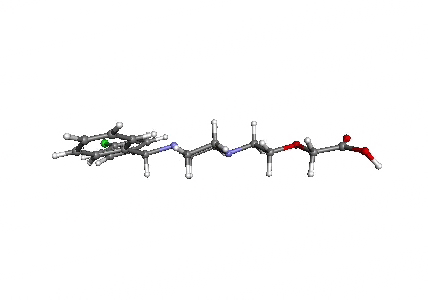Trade names Zyrtec MedlinePlus a698026 Routes ofadministration Oral CAS ID 83881-51-0 | AHFS/Drugs.com Monograph License data US FDA: Cetirizine Molar mass 388.89 g/mol | |
 | ||
Pregnancycategory US: B (No risk in non-human studies) | ||
Antihistamines video consult
Cetirizine /sɛˈtɪrᵻziːn/ (trade names Zirtec, Zyrtec, Reactine) is a second-generation antihistamine used in the treatment of hay fever, allergies, angioedema, and urticaria. It is a major metabolite of hydroxyzine, and a racemic selective H1 receptor antagonist.
Contents
- Antihistamines video consult
- Cetirizine
- Allergies
- Rhinovirus infection
- Kimuras disease
- Availability
- Adverse effects
- Pharmacodynamics
- Pharmacokinetics
- References
Second-generation antihistamines like cetirizine are less able to cross the blood–brain barrier and therefore have diminished effects on the central nervous system compared to first-generation drugs: for instance they are less likely to induce drowsiness or to interfere with memory formation.
Cetirizine
Allergies
Cetirizine's primary indication is for hay fever and other allergies. Because the symptoms of itching and redness in these conditions are caused by histamine acting on the H1 receptor, blocking those receptors temporarily relieves those symptoms.
Cetirizine is also commonly prescribed to treat acute and (in particular cases) chronic urticaria, more efficiently than any other second-generation antihistamine.
Rhinovirus infection
Interleukin 6 and interleukin 8 have been shown to be elevated in acute respiratory distress syndrome. Cetirizine contains L- and D-stereoisomers. Chemically, levocetirizine is the active L-enantiomer of cetirizine. One recent study of airway epithelial cells showed that levocetirizine may have beneficial effects on the pathophysiologic changes related to human rhinovirus (HRV) infection.
Kimura's disease
Cetirizine is an effective agent in treating the symptoms of Kimura's disease which predominantly affects the lymph nodes and soft tissue of the head and neck in the form of tumor-like lesions. Cetirizine's properties of being effective both in the treatment of pruritus (itching) and as an anti-inflammatory agent make it suitable for the treatment of the pruritus associated with these lesions. In a 2005 study, the American College of Rheumatology conducted treatments initially using prednisone, followed by steroid dosages and azathioprine, omeprazole, and calcium and vitamin D supplements over the course of two years. The skin condition of the patient began to improve and the skin lesions lessened. However, there were symptoms of cushingoid and hirsutism observed before the patient was removed from the courses of steroids and placed on 10 mg/day of cetirizine to prevent skin lesions; an agent suitable for the treatment of pruritus associated with such lesions. Asymptomatically, the patient's skin lesions disappeared after treatment with cetirizine, blood eosinophil counts became normal, corticosteroid effects were resolved, and a remission began within a period of two months. It is also thought that the inhibition of eosinophils may be the key to treatment of Kimura's disease due to the role of eosinophils, rather than other cells with regards to the lesions of the skin.
Availability
Formerly prescription-only in the US and Canada, cetirizine is now available over-the-counter (OTC) in both countries as Zyrtec and Reactine, respectively. Zyrtec was the highest-grossing new non-food product of 2008 in the US, generating sales of $315.9 million. It is also available as a generic drug. In Turkey, Iran, Australia and New Zealand (in the latter of which it is marketed as Razene), Zyrtec is available over-the-counter in pharmacies, and in the UK, Norway and The Netherlands cetirizine can be sold in limited quantities off-the-shelf in any outlet and is often available in supermarkets. In 2009, Germany made many generic drugs containing cetirizine available in pharmacies without prescription. Sweden, Finland, Poland, and Israel also classify cetirizine as an over-the-counter medicine.
In Ireland, cetirizine is known as Zirtek (as well as under generic names), and is available OTC in limited quantities (usually no more than seven tablets per pack).
Like many other antihistamine medications, cetirizine is commonly prescribed in combination with pseudoephedrine hydrochloride, a decongestant. These combinations are marketed using the same brand name as the cetirizine with a "-D" suffix (Zyrtec-D, Virlix-D, etc.)
Adverse effects
Commonly reported side effects of cetirizine include headache (16%), dry mouth (5.7%), and drowsiness (5–20%) or fatigue (5.6%).
Pharmacodynamics
Cetirizine crosses the blood–brain barrier only slightly, reducing the sedative side-effect common with older antihistamines. It has also been shown to inhibit eosinophil chemotaxis and LTB4 release. At a dosage of 20 mg, Boone et al. found that it inhibited the expression of VCAM-1 in patients with atopic dermatitis. Unlike many other antihistamines, Cetirizine does not exhibit anticholinergic properties.
The levorotary enantiomer of cetirizine, known as levocetirizine, is the more active form.
Pharmacokinetics
Chewable, non-chewable, and syrup forms of cetirizine are similarly absorbed rapidly and effectively, with absorbed food minutely affecting the absorption rate which yields a peak serum level one hour after administration; in a study of healthy volunteers prescribed 10 mg tablets, once daily for 10 days, a mean peak serum level of 311 ng/mL was observed. The metabolic effects of cetirizine are long-acting, remaining in the system for a maximum of 21 hours before being excreted; the average elimination half-life is 8 hours. About 70% of the drug is removed through urination, of which half is observed as unchanged cetirizine compound. Another 10% is excreted.
The 1-[(4-chlorophenylmethyl]-piperazine is alkylated with methyl (2-chloroethoxy)-acetate in the presence of sodium carbonate and xylene solvent to produce the Sn2 substitution product in 28% yield. Saponification of the acetate ester is done by refluxing with potash in absolute ethanol to afford a 56% yield of the potassium salt intermediate. This is then hydrolyzed with aqueous HCl and extracted to give a 81% yield of the carboxylic acid product.
